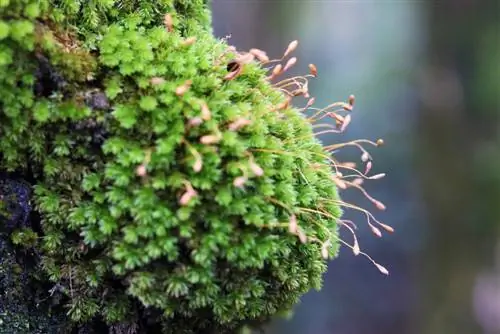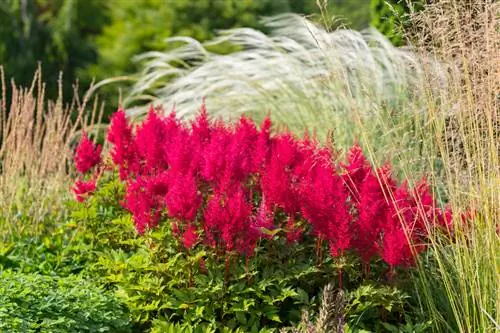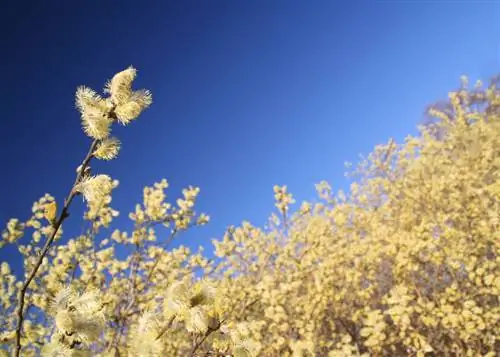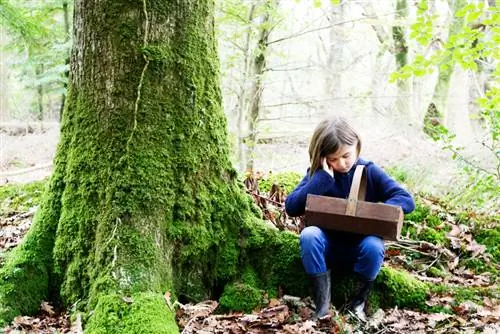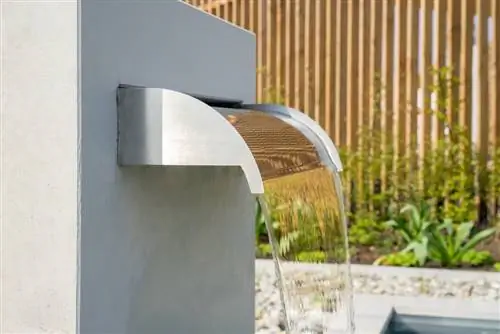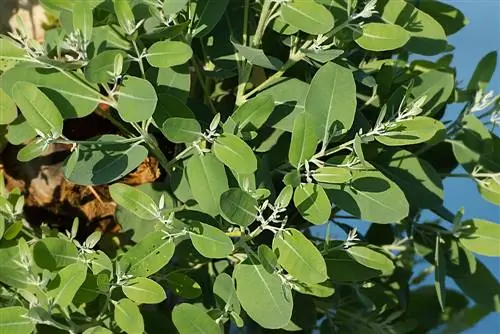- Author admin [email protected].
- Public 2023-12-16 16:46.
- Last modified 2025-01-23 11:22.
Read a commented leaf moss profile here with explanations of growth, generational change and Bryophyta species. Tips worth reading explain how to properly plant and care for deciduous moss.
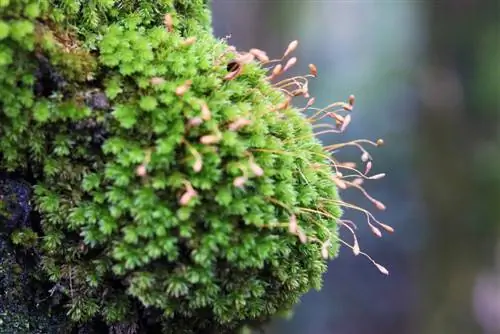
What are the characteristics and requirements of deciduous moss?
Leaf moss belongs to the Bryophyta species and is a rootless land plant that occurs worldwide. It is characterized by its evergreen phyllodes, its winter hardiness and its propagation by alternation of generations or brood bodies. Mosses thrive best in partially shaded to shady locations with moist, acidic soil.
Profile
- Scientific name: Bryophyta
- Kingdom: Land Plants (Embryophyta)
- Department: Mosses with 15,000 species
- Occurrence: worldwide
- Growth type: rootless land plant
- Growth habit: ground cover
- Growth height: 1 mm to 50 cm
- Leaf: evergreen phylloid
- Flowering: omitted
- Toxicity: non-toxic
- Winter hardiness: hardy
- Reproduction: alternation of generations (generative), brood bodies (vegetative)
Growth
Leaf moss has colonized the earth from the tropics to Antarctica for 400 million years. Together with liverworts and hornworts, leaf mosses form the three well-known families of mosses in the land plant kingdom. In contrast to perennials, Bryophyta mosses have no real roots, shoot axes, leaves or vessels for transporting water and nutrients. Instead, moss species form specific structures that are similar to the organs of a seed plant. The following key growth data provide details worth knowing:
- Growth habit: Stems with tiny leaf-like structures, cushion-forming, ground-covering.
- Growth height: 1 mm to 40 cm (Central Europe).
- Roots: Rhizoids (root-replacing threads, multicellular and branched for anchoring in the soil).
- Gardenically interesting properties: hardy, evergreen, carpet-forming, extremely robust and resistant.
Generation change
Growth and reproduction of deciduous moss are characterized by a change in generations. The sexual generation (gametophyte) dominates over the asexual generation (sporophyte). A gametophyte forms the actual moss plant with its stems and leaves. This generation feeds itself independently through photosynthesis and can reproduce sexually.
In contrast, the sporophyte consists only of a stalk with a terminal spore capsule. It cannot supply itself with nutrients, is dependent on the gametophyte and therefore represents the asexual generation. The spores distributed by wind and water initially form protonema, consisting of multicellular, extremely thin threads. New gametophytes develop from this and the cycle of life begins again. The following video explains the details:
Video: Generational change in algae, ferns and moss
Leaf
Leaf moss does not have leaves like you know from perennials, trees or bushes. Delicate, leaf-like structures, known in technical jargon as phyllodes, sit on the stems. This is a flat, leaf-shaped network of cells with a midrib. As a rule, the leaf moss leaves are arranged spirally on the stem. The only thing they have in common with the leaves of vascular plants is their function. Phylloids and true leaves are plant organs responsible for photosynthesis.
Moss species
Of the more than 16,000 moss species known worldwide, deciduous moss is the largest division. Representing the immense diversity of species, the following table presents five well-known mosses as examples:
| Types of deciduous moss | Medium Sphagnum Moss | Golden maidenhair moss | Upholstery cushion moss | Silvermoss | Spring moss |
|---|---|---|---|---|---|
| Botanical name | Sphagnum angustifolium | Polytrichum commune | Grimmia pulvinata | Bryum argenteum | Fontinalis antipyretica |
| Growth | 10-20 cm | 10-40 cm | 1-2 cm | 0, 3-1 cm | 5-40 cm |
| Coloring | bright green | dark green, blue-green | ice grey | silvery-green to blue-green | dark green |
| Speciality | Moss of the Year 2016 | yellow-red-brown spore capsules | Stem forked branched | steady | Underwater moss |
Alpine wideton moss (Polytrichastrum alpinum) is interesting for creative garden design. Its densely leafed stems, up to 20 cm long, are branched again at the top. We recommend swamp peat moss (Sphagnum palustre) for waterlogged, boggy locations as greenery for problematic locations, as well as Girgensohn's peat moss (Sphagnum girgensohnii) for decorative moss cushions on acidic soil with a pH value of 3.0 to 4.5.
Planting moss
Ready-to-plant leaf moss can be bought inexpensively as a potted moss cushion in nurseries and on Amazon (€13.00 on Amazon). Hobby gardeners like to choose planting through propagation. The best planting time is from April to September. Leaf moss has modest requirements when it comes to a suitable location. How and where you can successfully plant leaf moss in the garden can be found here:
Propagation
There are three simple methods to choose from for propagating leaf moss. Dried moss pads are brought back to life by water. If a gametophyte is passed through a kitchen sieve, complete gametophytes are formed from the individual parts. Ripe spore capsules on the sporophyte are suitable for sowing, as you know from flower seeds. Practical tips and tricks for propagating leaf moss:
- Collecting moss: Collect pieces of moss in the forest or garden using a spatula.
- Propagation on the windowsill: Fill the bowl with a mixture of cactus soil and sand, moisten it, press pieces of moss into the substrate at a distance of 5-8 cm with tweezers, put over the plastic bag.
- Propagation on stone: pass moist moss stems through a sieve, mix with buttermilk, apply moss milk to a stone base.
- Collect sporophytes: cut off stems with ripe spore capsules protruding from moss cushions, crush capsules on a plate.
- Spore sowing: Fill the seed tray with coconut soil, moisten it, pick up leaf moss spores with a brush, spread onto the substrate, keep constantly moist under a transparent hood.
Location
Leaf moss grows wherever it can anchor itself in the ground with its rhizoids. Beautiful, dense cushions form in a location with these basic conditions:
- Part shade to shade.
- Cool and humid, preferably under trees or near a pond or stream.
- Fresh, moist, lean, acidic garden soil with a pH value of 4.0 to 6.0.
A few sun worshipers among the deciduous moss species are suitable for a sunny location. These include the juniper red clay moss (Polytrichum juniperinum) and the indestructible bellweed moss (Encalypta vulgaris).
Planting instructions
Leaf moss purchased or grown ready to plant is easy to plant. Of course, the planting technique requires a rethink because the land plant does not have a root ball. The following instructions explain step by step how to properly plant leaf moss in the bed:
- Weed weeds, rake the soil into fine crumbs, test the pH value (if the value is greater than 6.0, incorporate ericaceous soil).
- Moisten the bed area with rainwater.
- Press leaf moss patches into the soil at a distance of 5 cm to 10 m.
Finally, water the moss area with a fine spray. With a few modifications, these instructions can be applied to planting deciduous moss as a houseplant.
Excursus
Laubmoss Member of the Pavement Cracks Third Party
In the middle of the big city, Laubmoss proves its unshakable will to survive. As a ubiquitous species of deciduous moss, silver moss (Bryum argentum) forms the paving crack community together with prostrate meadow (Sagina procumbens) and annual bluegrass (Poa annua). Unnoticed by hurried people, the three survival artists populate curbs, train platforms and paved sidewalks. The leaf moss cleverly ducks into cracks in the pavement to avoid the impact of foot traffic.
Maintaining deciduous moss
Mass care is very simple. Regular water supply is important for velvety green, dense growth. This is best achieved with collected rainwater from a watering can with a shower head. Because mosses are extremely weak in competition, occasional weeding ensures a well-groomed appearance. Any care measures beyond this, such as fertilizing, cutting or overwintering, must be canceled without replacement.
Popular varieties
Beyond the five protagonists in the table of moss species above, these moss species are widespread in Germany:
- Felt cap moss (Pogonatum urnigerum): boasts reddish-brown boll caps at the top of the sporophyte stem.
- Beautiful Widertonmoss (Polytrichastrum formosum): magnificent forest moss with blue-green, star-shaped moss cushions, height 5-15 cm.
- White moss, order cushion moss (Leucobryum glaucum): wet, light green stems form white, arched cushions when dry, growth height 10 cm to 20 cm.
- Green goblin moss (Buxbaumia viridis): above ground only shows its sporophyte with a 1 cm large green spore capsule on the orange-brown stem.
FAQ
Is deciduous moss suitable as a houseplant?
Mass is a popular design element in modern living spaces. The rootless land plants are trendy as easy-care moss cushions in decorative glass cylinders, combined with decorative elements. Leaf moss comes into its own in shallow bowls on a coconut substrate. Leaf moss goes well with a bonsai as an underplant. In the terrarium, leaf moss is useful as an evergreen substrate.
What is the difference between liverwort and broadleaf moss?
The naming provides an important clue to the difference. Liverwort (Marchantiophyta) thrives with a fleshy, lobed plant body that is reminiscent of a liver-shaped leaf. Deciduous moss (Bryophyta), on the other hand, forms dense moss cushions with leafy stems up to 50 cm long.
What is the solution for moss in the crossword puzzle?
In the crossword puzzle, a solution word with 10 letters is usually sought for moss. The correct answer is: women's hair.

